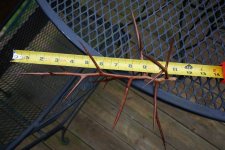jaxs
Elite Member
First things first then we can discuss how to dispose of downed trees and brush.
The reason you have a grove in one spot is because there was a single tree standing in that spot and whom ever removed it didn't follow advice I'm giving you. When a Honey Locust is cut down or dozed out dozens of pups will sprout from roots and grow faster than newly planted trees because they already have an established root system. The prefered method is spraying entire canopy with brush killer in late Spring to early Summer then leave standing until Fall or following Spring before removing. The main hurdle is preventing herbacide drifting to crops,resedintial landscaping and other desirable plants. If equipment and expertise can't be mustered,secound choice is ringing and/or injecting trunk. 3rd choice is dozing or logging followed up with a concentrated program spraying sprouts after they emerge and fully leaf out,and continuing to hand spray resprouts up to three years. Eliminating all those trees can cause new problems or yield a free bonanza depending on how vigilant you are in managing the ground. The ground where trees stood will be as productive as ground elsewhere following an intensive 5 year soil improvement program. Honey Locust is 1st cousin to Hairy Vetch,beans and other legumes that fix nitrogen in soil. If you don't cultivate or plant the ground nature will plant it. If you would like other trees,check their sensitivity to herbicide that was used and how long herbicide persists on soil. Grasses aren't sensitive to most brush killers so you can plant it in Rye during cool season and warm weather grass in Summer to suppress unwanted plants.
You can buy a 3-4 ton 12 volt winch for less than $700 and move logs using your tractor and trees to anchor snatch blocks.
The reason you have a grove in one spot is because there was a single tree standing in that spot and whom ever removed it didn't follow advice I'm giving you. When a Honey Locust is cut down or dozed out dozens of pups will sprout from roots and grow faster than newly planted trees because they already have an established root system. The prefered method is spraying entire canopy with brush killer in late Spring to early Summer then leave standing until Fall or following Spring before removing. The main hurdle is preventing herbacide drifting to crops,resedintial landscaping and other desirable plants. If equipment and expertise can't be mustered,secound choice is ringing and/or injecting trunk. 3rd choice is dozing or logging followed up with a concentrated program spraying sprouts after they emerge and fully leaf out,and continuing to hand spray resprouts up to three years. Eliminating all those trees can cause new problems or yield a free bonanza depending on how vigilant you are in managing the ground. The ground where trees stood will be as productive as ground elsewhere following an intensive 5 year soil improvement program. Honey Locust is 1st cousin to Hairy Vetch,beans and other legumes that fix nitrogen in soil. If you don't cultivate or plant the ground nature will plant it. If you would like other trees,check their sensitivity to herbicide that was used and how long herbicide persists on soil. Grasses aren't sensitive to most brush killers so you can plant it in Rye during cool season and warm weather grass in Summer to suppress unwanted plants.
You can buy a 3-4 ton 12 volt winch for less than $700 and move logs using your tractor and trees to anchor snatch blocks.

